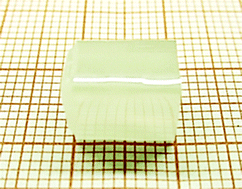A high quality lead-free (Li, Ta) modified (K, Na)NbO3 single crystal and its complete set of elastic, dielectric and piezoelectric coefficients with macroscopic 4mm symmetry
Abstract
A high quality orthorhombic (K, Na, Li)(Nb, Ta)O3 single crystal with a large size of 9 × 9 × 11 mm3 was successfully grown using the top-seeded solution growth method. Its large size allowed us to perform comprehensive investigation on this crystal. A complete set of elastic, dielectric and piezoelectric coefficients was determined using combined resonance and ultrasonic methods. The longitudinal piezoelectric coefficient d33 and the transverse piezoelectric coefficient d31 of this lead-free piezoelectric single crystal are as high as 354 pC N−1 and −163 pC N−1, respectively, which are two times higher than those of KNN-TL ceramics and are comparable with those of PZT5. The electromechanical coupling factor k33 is as high as 82%, much higher than those of KNN-TL ceramics and PZT5. The coefficient d33,strain was found to be as high as 672 pm v−1 and the extrinsic contribution (~22%) was investigated by Rayleigh analysis. These high piezoelectric properties make this single crystal a promising candidate for replacing lead-based piezoelectric materials.


 Please wait while we load your content...
Please wait while we load your content...